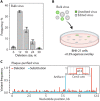CRISPR-based engineering of RNA viruses
- PMID: 37703376
- PMCID: PMC10499312
- DOI: 10.1126/sciadv.adj8277
CRISPR-based engineering of RNA viruses
Abstract
CRISPR RNA-guided endonucleases have enabled precise editing of DNA. However, options for editing RNA remain limited. Here, we combine sequence-specific RNA cleavage by CRISPR ribonucleases with programmable RNA repair to make precise deletions and insertions in RNA. This work establishes a recombinant RNA technology with immediate applications for the facile engineering of RNA viruses.
Figures




Update of
-
CRISPR-based engineering of RNA viruses.bioRxiv [Preprint]. 2023 May 20:2023.05.19.541219. doi: 10.1101/2023.05.19.541219. bioRxiv. 2023. Update in: Sci Adv. 2023 Sep 15;9(37):eadj8277. doi: 10.1126/sciadv.adj8277. PMID: 37292641 Free PMC article. Updated. Preprint.
Similar articles
-
CRISPR-based engineering of RNA viruses.bioRxiv [Preprint]. 2023 May 20:2023.05.19.541219. doi: 10.1101/2023.05.19.541219. bioRxiv. 2023. Update in: Sci Adv. 2023 Sep 15;9(37):eadj8277. doi: 10.1126/sciadv.adj8277. PMID: 37292641 Free PMC article. Updated. Preprint.
-
Repair of CRISPR-guided RNA breaks enables site-specific RNA editing in human cells.bioRxiv [Preprint]. 2023 Aug 29:2023.08.29.555404. doi: 10.1101/2023.08.29.555404. bioRxiv. 2023. Update in: Science. 2024 May 17;384(6697):808-814. doi: 10.1126/science.adk5518. PMID: 37693568 Free PMC article. Updated. Preprint.
-
Precise and heritable genome editing in evolutionarily diverse nematodes using TALENs and CRISPR/Cas9 to engineer insertions and deletions.Genetics. 2013 Oct;195(2):331-48. doi: 10.1534/genetics.113.155382. Epub 2013 Aug 9. Genetics. 2013. PMID: 23934893 Free PMC article.
-
CRISPR technology to combat plant RNA viruses: A theoretical model for Potato virus Y (PVY) resistance.Microb Pathog. 2019 Aug;133:103551. doi: 10.1016/j.micpath.2019.103551. Epub 2019 May 22. Microb Pathog. 2019. PMID: 31125685 Review.
-
Class 2 CRISPR-Cas RNA-guided endonucleases: Swiss Army knives of genome editing.Nat Struct Mol Biol. 2017 Nov;24(11):882-892. doi: 10.1038/nsmb.3486. Epub 2017 Oct 16. Nat Struct Mol Biol. 2017. PMID: 29035385 Review.
Cited by
-
RNA and Single-Stranded DNA Phages: Unveiling the Promise from the Underexplored World of Viruses.Int J Mol Sci. 2023 Dec 1;24(23):17029. doi: 10.3390/ijms242317029. Int J Mol Sci. 2023. PMID: 38069353 Free PMC article. Review.
-
Repair of CRISPR-guided RNA breaks enables site-specific RNA excision in human cells.Science. 2024 May 17;384(6697):808-814. doi: 10.1126/science.adk5518. Epub 2024 Apr 25. Science. 2024. PMID: 38662916 Free PMC article.
-
CRISPR-Cas systems: A revolution in genome editing and its diverse applications.J Biomed Res (Middlet). 2024;5(1):108-114. doi: 10.46439/biomedres.5.050. J Biomed Res (Middlet). 2024. PMID: 40612691 Free PMC article.
-
Discovery of Diverse CRISPR Leader Motifs, Putative Functions, and Applications for Enhanced CRISPR Detection and Subtype Annotation.CRISPR J. 2025 Apr;8(2):137-148. doi: 10.1089/crispr.2024.0093. Epub 2025 Jan 8. CRISPR J. 2025. PMID: 39792480
References
MeSH terms
Substances
Grants and funding
LinkOut - more resources
Full Text Sources

